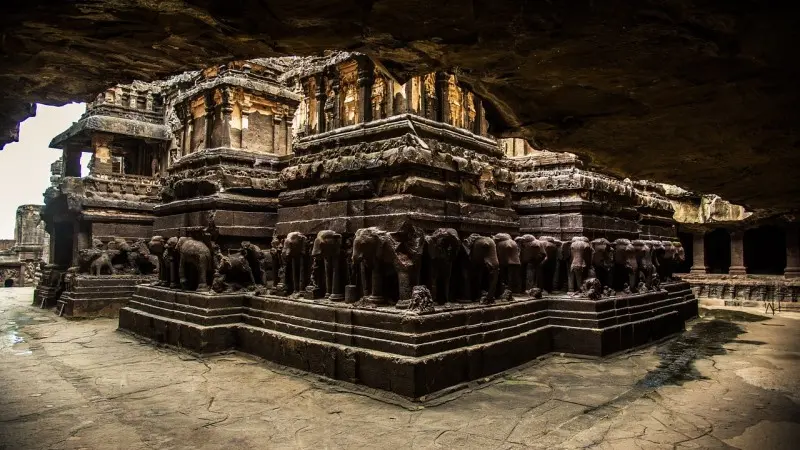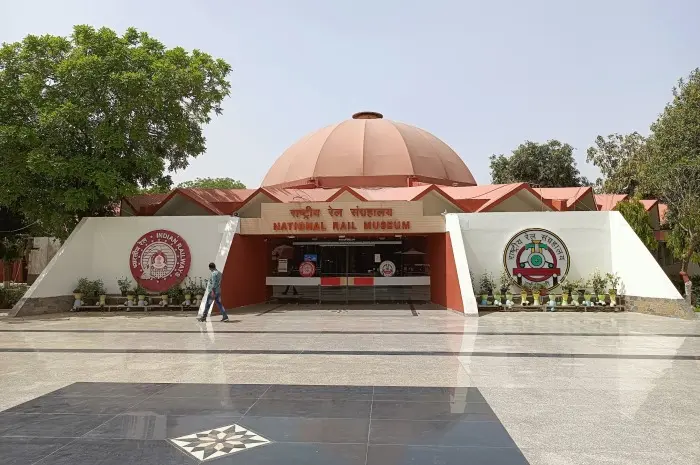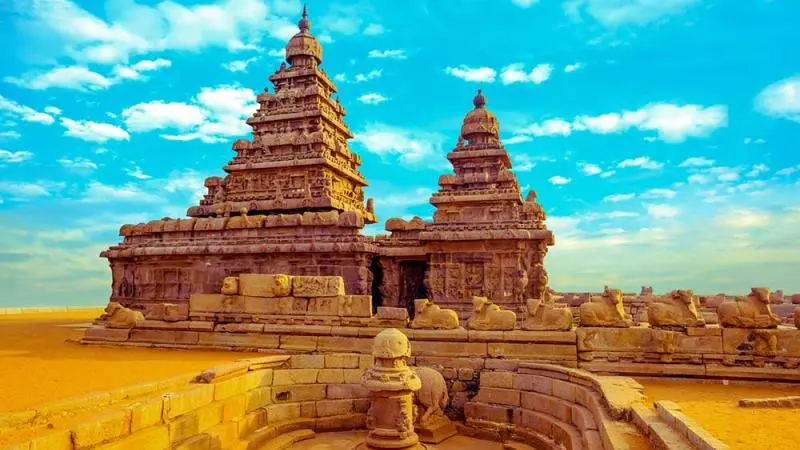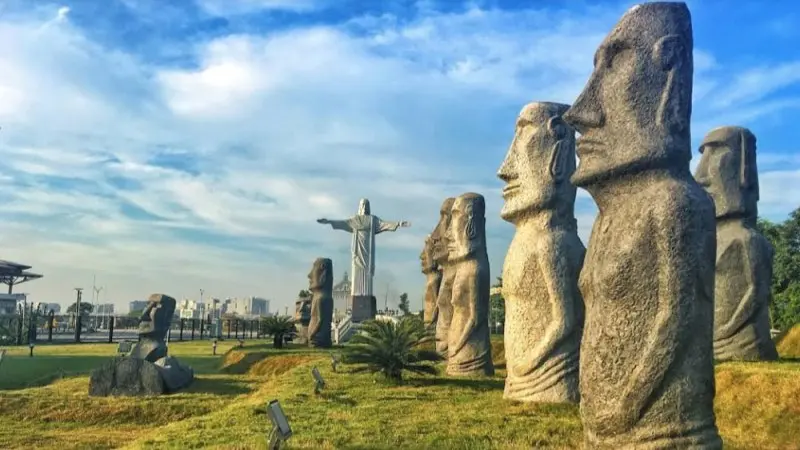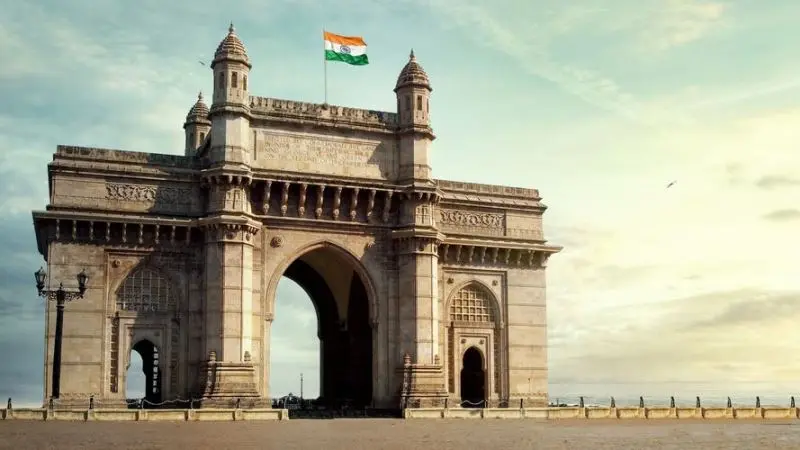| Entry Fee: 40 INR; Location: Check Map Address: Aurangabad, Verul, Maharashtra 431102, India. |
The Ellora Caves, located in the Aurangabad district of Maharashtra, India, are an exceptional testament to the artistic and architectural achievements of ancient India. Carved into the basalt rock of the Charanandri Hills, the Ellora Caves form one of the world’s largest rock-cut temple complexes. This UNESCO World Heritage Site is renowned for its unique fusion of Hindu, Buddhist, and Jain religious art and architecture.
The Ellora Caves encompass a total of 34 monastic structures, including temples, viharas (monasteries), and chapels. These caves were constructed over a span of several centuries, from the 6th to the 10th century CE, under the patronage of different dynasties, including the Rashtrakutas, Chalukyas, and Yadavas. The site stands as a testament to the harmonious coexistence of different religious traditions during that era.
The caves at Ellora showcase the artistic excellence and engineering prowess of ancient Indian craftsmen. The intricate carvings, elaborate sculptures, and grand architectural elements carved into the rock walls are a testament to the creativity and dedication of the artisans who meticulously transformed the solid rock into magnificent religious sanctuaries.
The site is divided into three sections: the Hindu Caves, the Buddhist Caves, and the Jain Caves. Each section represents a different religious tradition and showcases the distinct artistic styles and architectural features associated with that particular faith.
Visiting the Ellora Caves offers a unique opportunity to delve into the rich cultural heritage of ancient India, admire the stunning artwork and sculptures, and gain insights into the spiritual beliefs and practices of the time. The caves provide a glimpse into the artistic and religious expressions of three major religions and serve as a source of inspiration for art enthusiasts, historians, and spiritual seekers alike.
The History of the Ellora Caves
1. Origins and Development of the Ellora Caves
The Ellora Caves have a rich history that spans several centuries. The construction of the caves began around the 6th century CE, during the reign of the Rashtrakuta dynasty. It is believed that the earliest caves were carved by Buddhist monks, reflecting the influence of the Mahayana and Vajrayana Buddhist traditions.
As time passed, other dynasties, such as the Chalukyas and the Yadavas, continued the tradition of carving caves at Ellora. The patronage of these dynasties contributed to the expansion and development of the site. The architectural styles, sculptural details, and religious themes evolved and diversified over the centuries, creating a unique blend of artistic expressions.
2. Influence of Different Dynasties and Religious Groups
The Ellora Caves showcase the cultural and religious diversity of ancient India. The site was influenced by the religious beliefs and practices of Hinduism, Buddhism, and Jainism. Each religious tradition left its mark on the caves, resulting in a magnificent synthesis of architectural styles and artistic motifs.
The Hindu caves at Ellora exhibit elements of Nagara-style architecture, characterized by elaborate carvings and towering spires. These caves are dedicated to various Hindu deities, such as Shiva, Vishnu, and Durga. The most famous Hindu cave is the Kailash Temple (Cave 16), an astonishing feat of rock-cut architecture that replicates Mount Kailash, the mythical abode of Lord Shiva.
The Buddhist caves at Ellora represent the Mahayana and Vajrayana schools of Buddhism. They feature intricately carved sculptures of Buddha, bodhisattvas, and other celestial beings. The Buddhist caves served as monastic complexes for meditation, teaching, and religious rituals.
The Jain caves at Ellora highlight the principles and teachings of Jainism. They contain exquisite sculptures of Jain Tirthankaras (spiritual teachers) and elaborate ornamentation. The Jain caves reflect the principles of non-violence, simplicity, and spiritual purity.
3. Significance as a UNESCO World Heritage Site
The Ellora Caves were recognized as a UNESCO World Heritage Site in 1983. The site is regarded as an outstanding example of rock-cut architecture and represents the cultural and artistic achievements of ancient India.
The caves at Ellora offer valuable insights into the history, religion, and art of the time. They serve as a testament to the religious harmony that prevailed during the medieval period, with Hindu, Buddhist, and Jain communities coexisting and contributing to the artistic heritage of the site.
Architectural Marvels
The Ellora Caves are renowned for their architectural brilliance and remarkable rock-cut structures. The craftsmanship and engineering skills involved in creating these caves from solid rock are awe-inspiring. Here are some key aspects that make the Ellora Caves architectural marvels:
1. Rock-Cut Architecture and Craftsmanship
The most striking feature of the Ellora Caves is their rock-cut architecture. The caves were meticulously carved out of solid basalt rock, a challenging task that required immense skill and precision. The artisans employed hammers, chisels, and other hand tools to meticulously carve intricate details, creating magnificent structures within the rock face.
2. Layout and Structure of the Caves
The caves at Ellora are organized into three distinct sections: the Hindu Caves, the Buddhist Caves, and the Jain Caves. Each section comprises multiple caves, forming a complex network of religious structures. The layout is designed to facilitate worship, meditation, and community activities.
The caves typically consist of a main hall, often with pillars and decorative motifs, leading to an inner sanctum where the deity or object of reverence is placed. Some caves also have additional chambers, cells, and meditation halls. The overall architectural layout and design of the caves exhibit careful planning and adherence to religious principles.
The architectural styles in the Ellora Caves vary depending on the religious affiliation of the cave. The caves exhibit a blend of regional architectural influences, showcasing the artistic achievements of different dynasties and religious communities.
Cave Temples
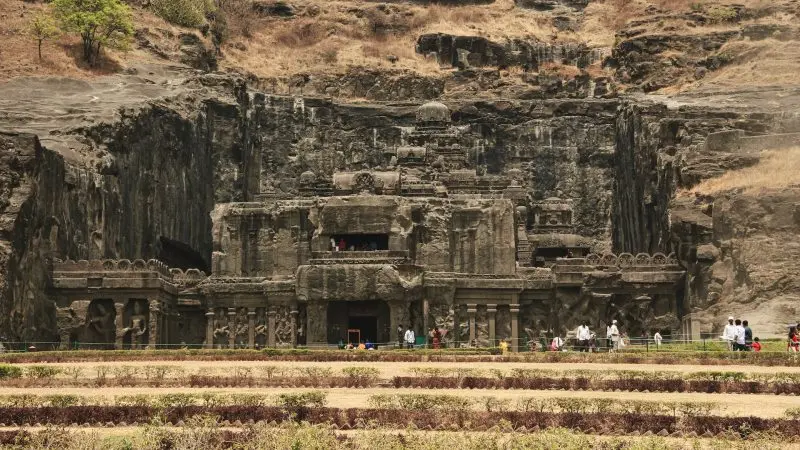
The Ellora Caves are home to a magnificent array of cave temples that serve as religious sanctuaries and showcase the diverse religious traditions of Hinduism, Buddhism, and Jainism. Each set of cave temples represents a distinct religious affiliation, featuring unique architectural styles and sculptural elements. Here are some notable cave temples at Ellora:
1. Hindu Caves
- Kailash Temple (Cave 16)
The Kailash Temple is the most renowned and awe-inspiring cave temple at Ellora. Carved out of a single rock, it is an extraordinary example of rock-cut architecture. The temple is dedicated to Lord Shiva and replicates Mount Kailash, the mythical abode of the deity. Intricate carvings, exquisite sculptures, and elaborate architectural elements adorn the temple, including elephants, deities, and mythological scenes.
- Dasavatara Cave (Cave 15)
The Dasavatara Cave is dedicated to Lord Vishnu, the preserver of the Hindu trinity. The cave showcases sculptures depicting the ten incarnations (avatars) of Lord Vishnu, including Matsya, Kurma, Varaha, and Krishna. Intricately carved pillars, ceiling decorations, and narrative reliefs enhance the beauty of this cave temple.
- Rameshvara Cave (Cave 21)
The Rameshvara Cave is dedicated to Lord Shiva and showcases the Lingam, a symbol of his divine presence. The cave features intricately carved pillars, ceiling panels, and figures of deities and celestial beings. The sanctum of the temple houses a beautifully carved Lingam, surrounded by intricate sculptures.
2. Buddhist Caves
- Vishvakarma Cave (Cave 10)
The Vishvakarma Cave is a significant Buddhist cave at Ellora, exhibiting a unique architectural design. The cave resembles a Buddhist monastery with cells, halls, and meditation chambers. Intricate carvings of Buddha, bodhisattvas, and other celestial figures adorn the walls, pillars, and ceilings.
- Mahavira Cave (Cave 32)
The Mahavira Cave is dedicated to Lord Mahavira, the 24th Tirthankara of Jainism. The cave showcases sculptures of Tirthankaras, celestial beings, and Jain motifs. Elaborate carvings and detailed reliefs make this cave a remarkable example of Jain art and architecture.
- Vajrapani Cave (Cave 1)
The Vajrapani Cave features a large statue of Vajrapani, a powerful Bodhisattva in Mahayana Buddhism. Intricate carvings of Buddhist deities and scenes from the life of Buddha adorn the walls of the cave.
3. Jain Caves
- Indra Sabha (Cave 32)
The Indra Sabha is a magnificent Jain cave temple known for its elaborate carvings and decorative motifs. The cave showcases sculptures of Jain Tirthankaras, celestial beings, and Jain symbols. Intricate details and artistic finesse make this cave a visual delight.
- Chota Kailash (Cave 30)
The Chota Kailash cave temple is dedicated to Lord Shiva and imitates the Kailash Temple on a smaller scale. The cave features detailed carvings of deities, mythological scenes, and religious motifs.
- Jagannath Sabha (Cave 33)
The Jagannath Sabha is a Jain cave known for its beautifully carved sculptures of Jain Tirthankaras. The cave also features intricately decorated pillars and ornamental reliefs.
Cultural Significance
The Ellora Caves hold immense cultural significance as they represent the convergence of multiple religious traditions, the artistic achievements of ancient India, and the religious harmony that prevailed during that era. Here are some key aspects that highlight the cultural significance of the Ellora Caves:
1. Religious and Pilgrimage Destination
Hinduism:
The Hindu caves at Ellora, dedicated to various deities, serve as important pilgrimage sites for followers of Hinduism. Devotees visit the caves to offer prayers, seek blessings, and engage in religious rituals associated with their respective deities. The temples within the caves are considered sacred spaces that foster spiritual connection and devotion.
Buddhism:
The Buddhist caves at Ellora attract followers of Buddhism and those interested in the teachings of Buddha. Visitors come to meditate, reflect, and pay homage to the enlightened ideals represented by the Buddhist sculptures and symbols. The caves provide a serene and tranquil environment conducive to contemplation and spiritual growth.
Jainism:
The Jain caves at Ellora are significant for followers of Jainism. Jain devotees visit these caves to honor the Tirthankaras, seek spiritual guidance, and deepen their understanding of Jain principles. The caves provide a space for meditation, reflection, and reverence for the Jain community.
2. Reflection of Religious Harmony
The Ellora Caves serve as a remarkable example of religious harmony and peaceful coexistence. The site showcases the blending of Hindu, Buddhist, and Jain religious art and architecture. The proximity of these caves and their harmonious integration reflect the tolerance, respect, and shared cultural heritage among different religious communities during the medieval period in India.
3. Influence on Regional Art and Architecture
The artistic styles, sculptural motifs, and architectural techniques seen at the Ellora Caves have had a significant influence on regional art and architecture. The intricate carvings, elaborate sculptures, and rock-cut architecture of the caves served as a source of inspiration for subsequent temples, sculptures, and architectural endeavors in different parts of India.
Visitor Experience
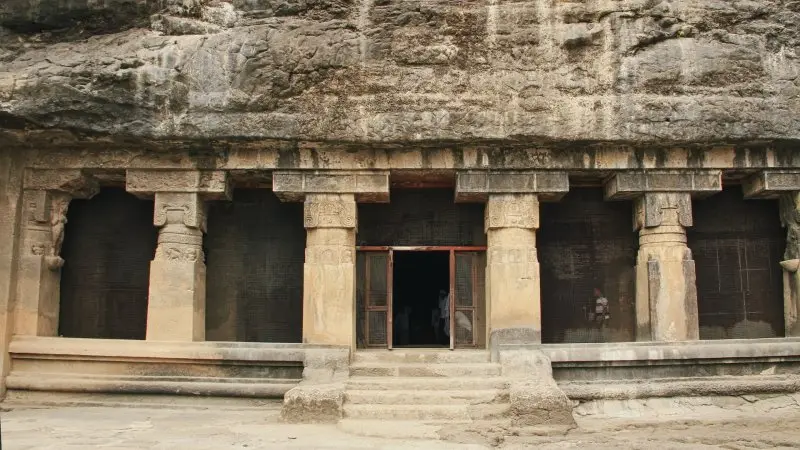
Visiting the Ellora Caves offers a captivating and enriching experience for travelers, history enthusiasts, and spiritual seekers. Here are some key aspects of the visitor experience at the Ellora Caves:
1. Entry and Ticketing Information
- Entry Points: The Ellora Caves have designated entry points from where visitors can access the site. The main entry point is located near Cave 16, which houses the Kailash Temple.
- Ticketing: Visitors need to purchase entry tickets to access the Ellora Caves. Tickets are available at the entrance, and rates may vary for domestic and international visitors. It is advisable to check the official website or local authorities for updated ticket prices and any additional regulations.
2. Guided Tours and Audio Guides
- Guided Tours: Guided tours are available at the Ellora Caves, allowing visitors to explore the site with the assistance of knowledgeable guides. Guides provide insights into the historical, cultural, and architectural aspects of the caves, enhancing the visitor’s understanding and appreciation of the site. Guided tours can be organized through authorized agencies or guides available at the entrance.
- Audio Guides: Audio guides are often available for rent at the entrance, providing a self-guided tour experience. These audio guides offer detailed commentary, historical information, and interesting anecdotes about the caves. Visitors can explore the caves at their own pace, listening to the audio guide and immersing themselves in the rich history and cultural significance of each cave.
3. Conservation Efforts and Visitor Facilities
- Conservation: The Ellora Caves are under the care and protection of archaeological and cultural authorities to ensure their preservation. Visitors are encouraged to respect the site’s historical and cultural value by adhering to guidelines, such as refraining from touching the sculptures or defacing the cave walls.
- Visitor Facilities: Visitor facilities, such as restrooms, drinking water, and seating areas, are available within the premises. Some areas may have stalls selling snacks, refreshments, and souvenirs. It is advisable to wear comfortable footwear and carry sun protection, as the site can involve walking and exposed areas.
4. Immersive Experience and Spiritual Reflection
- Awe-Inspiring Surroundings: The grandeur of the rock-cut architecture, the intricate sculptures, and the serene ambiance of the caves create a sense of awe and wonder. The natural surroundings, with the Charanandri Hills as a backdrop, enhance the spiritual and mystical atmosphere.
- Spiritual Reflection: The Ellora Caves offer an opportunity for spiritual reflection and contemplation. Visitors can find peaceful spots for meditation, connect with the spiritual energy of the site, and appreciate the devotion and craftsmanship of the ancient artisans.
- Photography and Souvenirs: Photography is usually allowed at the Ellora Caves, except in certain restricted areas. Visitors can capture the beauty of the caves, the intricate sculptures, and their own personal experiences. Souvenir shops near the entrance offer a range of handicrafts, replicas of sculptures, books, and other mementos for visitors to take home.
Places To Visit Near Ellora Caves
In addition to the awe-inspiring Ellora Caves, the surrounding area offers a variety of other attractions that further enrich the visitor’s experience. Here are some notable nearby attractions to explore:
1. Aurangabad Caves
Located approximately 10 kilometers from the Ellora Caves, the Aurangabad Caves are a group of 12 Buddhist caves dating back to the 2nd and 6th centuries CE. These caves showcase exquisite sculptures, intricate carvings, and beautiful paintings, providing insight into the Buddhist art and culture of the region.
2. Bibi Ka Maqbara
Often referred to as the “Taj of the Deccan,” Bibi Ka Maqbara is a mausoleum located in Aurangabad. Built in the 17th century, it bears a resemblance to the Taj Mahal and is dedicated to Rabia-ul-Daurani, the wife of Mughal Emperor Aurangzeb. The mausoleum features intricate marble work, stunning gardens, and a peaceful ambiance.
3. Daulatabad Fort
Situated around 16 kilometers from the Ellora Caves, Daulatabad Fort is a formidable hilltop fortress known for its strategic location and impressive architecture. Originally built in the 12th century, the fort features intricate defenses, secret passageways, and panoramic views of the surrounding countryside.
4. Grishneshwar Jyotirlinga Temple
Located near Ellora, the Grishneshwar Temple is one of the 12 Jyotirlingas, sacred shrines dedicated to Lord Shiva. The temple is known for its architectural beauty and religious significance, attracting devotees from far and wide.
5. Ajanta Caves
Situated approximately 100 kilometers from the Ellora Caves, the Ajanta Caves are another UNESCO World Heritage Site. These caves date back to the 2nd century BCE and are renowned for their exquisite Buddhist paintings and sculptures. The Ajanta Caves showcase a magnificent fusion of art, spirituality, and history.
Conclusion
The Ellora Caves stand as a testament to the rich cultural heritage, artistic brilliance, and religious harmony of ancient India. These remarkable rock-cut caves, with their stunning sculptures, intricate carvings, and grand architecture, continue to captivate visitors from around the world. The combination of Hindu, Buddhist, and Jain caves showcases the diversity and coexistence of different religious traditions during the medieval period.
The caves not only serve as important religious and pilgrimage sites but also offer a profound spiritual and cultural experience. They provide a glimpse into the religious beliefs, mythologies, and philosophies of Hinduism, Buddhism, and Jainism, fostering a deeper understanding of India’s ancient heritage.

